Distribution System Service Restoration Using Electric Vehicles
Abstract
:1. Introduction
2. Description of the Test System
3. Problem Formulation and Methodology
4. Results and Discussions
The Scenario at Hour 16
5. Conclusions
Author Contributions
Funding
Institutional Review Board Statement
Informed Consent Statement
Data Availability Statement
Acknowledgments
Conflicts of Interest
References
- Arias, N.B.; Hashemi, S.; Andersen, P.B.; Træholt, C.; Romero, R. Distribution System Services Provided by Electric Vehicles: Recent Status, Challenges, and Future Prospects. In IEEE Transactions on Intelligent Transportation Systems; IEEE: Boston, MA, USA, 2019; Volume 20, pp. 4277–4296. [Google Scholar] [CrossRef] [Green Version]
- Venegas, F.G.; Petit, M.; Perez, Y. Active integration of electric vehicles into distribution grids: Barriers and frameworks for flexibility services. Renew. Sustain. Energy Rev. 2021, 145, 111060. [Google Scholar] [CrossRef]
- Sun, W.; Kadel, N.; Alvarez-Fernandez, I.; Nejad, R.R.; Golshani, A. Optimal distribution system restoration using PHEVs. IET Smart Grid 2019, 2, 42–49. [Google Scholar] [CrossRef]
- Sharma, A.; Srinivasan, D.; Trivedi, A. A Decentralized Multi-Agent Approach for Service Restoration in Uncertain Environment. In Proceedings of the 2018 IEEE Power & Energy Society General Meeting (PESGM), Portland, OR, USA, 24 December 2018. [Google Scholar] [CrossRef]
- Shunbo, L.; Chen, C.; Zhou, H.; Hou, Y. Routing and Scheduling of Mobile Power Sources for Distribution System Resilience Enhancement. In IEEE Transactions on Smart Grid; IEEE: Boston, MA, USA, 2019; Volume 10, pp. 5650–5662. [Google Scholar] [CrossRef]
- Lei, S.; Chen, C.; Li, Y.; Hou, Y. Resilient Disaster Recovery Logistics of Distribution Systems: Co-Optimize Service Restoration with Repair Crew and Mobile Power Source Dispatch. In IEEE Transactions on Smart Grid; IEEE: Boston, MA, USA, 2019; Volume 10, pp. 6187–6202. [Google Scholar] [CrossRef] [Green Version]
- Zhu, R.; Andresen, M.; Langwasser, M.; Liserre, M.; Lopes, J.P.; Moreira, C.; Rodrigues, J.; Couto, M. Smart transformer/large flexible transformer. In CES Transactions on Electrical Machines and Systems; CES: Seoul, Korean, 2020; Volume 4, pp. 264–274. [Google Scholar] [CrossRef]
- Wang, Y.; Xu, Y.; Li, J.; Li, C.; He, J.; Liu, J.; Zhang, Q. Dynamic load restoration considering the interdependencies between power distribution systems and urban transportation systems. CSEE J. Power Energy Syst. 2020, 6, 772–781. [Google Scholar] [CrossRef]
- Golshani, A.; Sun, W.; Zhou, Q. PHEVs contribution to the self-healing process of distribution systems. In 2016 IEEE Power and Energy Society General Meeting (PESGM); IEEE: Boston, MA, USA, 2016; pp. 1–5. [Google Scholar] [CrossRef]
- Ferreira Neto, L.H.T.; Pereira, B.R.; da Costa, G.R.M. Smart Service Restoration of Electric Power Systems. In Proceedings of the 2016 IEEE Power and Energy Society General Meeting (PESGM), Boston, MA, USA, 14 November 2016; pp. 1–5. [Google Scholar] [CrossRef]
- Abilkhassenov, M.; Auketayeva, A.; Berikkazin, N.; Jamwal, P.K.; Nunna, H.S.V.S.K. Service Restoration in Power Distribution Systems using Hybrid Multi-Agent Approach. In Proceedings of the 2018 International Conference on Computing and Network Communications (CoCoNet), Astana, Kazakhstan, 15–17 August 2018; pp. 144–151. [Google Scholar] [CrossRef]
- Liu, X.; Ivanescu, L.; Kang, R.; Maier, M. Real-time household load priority scheduling algorithm based on prediction of renewable source availability. In IEEE Transactions on Consumer Electronics; IEEE: Boston, MA, USA, 2012; Volume 58, pp. 318–326. [Google Scholar] [CrossRef]
- Jia, H.; Jin, X.; Mu, Y.; Yu, X. A multi-level service restoration strategy of distribution network considering microgrids and electric vehicles. In Proceedings of the 2014 International Conference on Intelligent Green Building and Smart Grid (IGBSG), Taipei, Taiwan, 23–25 April 2014; pp. 1–4. [Google Scholar] [CrossRef]
- Hong, X.; Xia, M.; Han, Y. A service restoration method for active distribution network. Energy Procedia 2014, 61, 339–344. [Google Scholar] [CrossRef] [Green Version]
- Parast, M.E.; Nazari, M.H.; Hosseinian, S.H. Resilience Improvement of Distribution Networks Using a Two-Stage Stochastic Multi-Objective Programming via Microgrids Optimal Performance. In IEEE Access; IEEE: Boston, MA, USA, 2021; Volume 9, pp. 102930–102952. [Google Scholar] [CrossRef]
- Firoozi, H.; Khajeh, H.; Laaksonen, H. Optimized Operation of Local Energy Community Providing Frequency Restoration Reserve. In IEEE Access; IEEE: Boston, MA, USA, 2020; Volume 8, pp. 180558–180575. [Google Scholar] [CrossRef]
- Al-Muhaini, M. Electric Vehicle Markov-Based Adequacy Modeling for Electric Microgrids. In IEEE Access; IEEE: Boston, MA, USA, 2020; Volume 8, pp. 132721–132735. [Google Scholar] [CrossRef]
- Bilal, M.; Rizwan, M.; Alsaidan, I.; Almasoudi, F.M. AI-Based Approach for Optimal Placement of EVCS and DG With Reliability Analysis. In IEEE Access; IEEE: Boston, MA, USA, 2021; Volume 9, pp. 154204–154224. [Google Scholar] [CrossRef]
- Rezaeimozafar, M.; Eskandari, M.; Savkin, A.V. A Self-Optimizing Scheduling Model for Large-Scale EV Fleets in Microgrids. In IEEE Transactions on Industrial Informatics; IEEE: Boston, MA, USA, 2021; Volume 17, pp. 8177–8188. [Google Scholar] [CrossRef]
- Boudina, R.; Wang, J.; Benbouzid, M.; Yao, G.; Zhou, L. A Review on Stochastic Approach for PHEV Integration Control in a Distribution System with an Optimized Battery Power Demand Model. Electronics 2020, 9, 139. [Google Scholar] [CrossRef] [Green Version]
- Akil, M.; Dokur, E.; Bayindir, R. The SOC Based Dynamic Charging Coordination of EVs in the PV-Penetrated Distribution Network Using Real-World Data. Energies 2021, 14, 8508. [Google Scholar] [CrossRef]
- Aljanad, A.; Mohamed, A.; Shareef, H. Impact study of plug-in electric vehicles on electric power distribution system. In Proceedings of the 2015 IEEE Student Conference on Research and Development (SCOReD), Kuala Lumpur, Malaysia, 13–14 December 2015; pp. 339–344. [Google Scholar] [CrossRef]
- Hanschek, A.J.; Bouvier, Y.E.; Jesacher, E.; Grbović, P.J. Analysis and Comparison of Power Distribution System Topologies for Low-Voltage DC–DC Automated Guided Vehicle Applications. Energies 2022, 15, 2012. [Google Scholar] [CrossRef]
- Yan, Q.; Kezunovic, M. Impact analysis of Electric Vehicle charging on distribution system. In Proceedings of the 2012 North American Power Symposium (NAPS), Champaign, IL, USA, 22 October 2012; pp. 1–6. [Google Scholar] [CrossRef]
- Galiveeti, H.R.; Goswami, A.K.; Choudhury, N.B. Impact of plug-in electric vehicles and distributed generation on reliability of distribution systems. Eng. Sci. Technol. Int. J. 2018, 21, 50–59. [Google Scholar] [CrossRef]
- Ravi, S.S.; Aziz, M. Utilization of Electric Vehicles for Vehicle-to-Grid Services: Progress and Perspectives. Energies 2022, 15, 589. [Google Scholar] [CrossRef]
- Ammous, M.; Khater, M.; AlMuhaini, M. Impact of Vehicle-to-Grid Technology on the Reliability of Distribution Systems. In Proceedings of the 2017 9th IEEE-GCC Conference and Exhibition (GCCCE), Manama, Bahrain, 8–11 May 2017; pp. 1–6. [Google Scholar] [CrossRef]
- Liu, Y.; Fan, R.; Terzija, V. Power system restoration: A literature review from 2006 to 2016. J. Mod. Power Syst. Clean Energy 2016, 4, 332–341. [Google Scholar] [CrossRef] [Green Version]
- Vadi, S.; Bayindir, R.; Colak, A.M.; Hossain, E. A Review on Communication Standards and Charging Topologies of V2G and V2H Operation Strategies. Energies 2019, 12, 3748. [Google Scholar] [CrossRef] [Green Version]
- Mao, T.; Zhang, X.; Zhou, B. Modeling and Solving Method for Supporting ‘Vehicle-to-Anything’ EV Charging Mode. Appl. Sci. 2018, 8, 1048. [Google Scholar] [CrossRef] [Green Version]
- Global EV Outlook. Accelerating Ambitions Despite the Pandemic; International Energy Agency: Paris, France, 2021. [Google Scholar]
- Tomić, J.; Kempton, W. Using fleets of electric-drive vehicles for grid support. J. Power Sources 2007, 168, 459–468. [Google Scholar] [CrossRef]
- Affonso, C.M.; Kezunovic, M. Probabilistic Assessment of Electric Vehicle Charging Demand Impact on Residential Distribution Transformer Aging. In Proceedings of the 2018 IEEE International Conference on Probabilistic Methods Applied to Power Systems (PMAPS), Boise, ID, USA, 24–28 June 2018; pp. 1–6. [Google Scholar] [CrossRef]
- US Department of Energy. Estimating Appliance and Home Electronic Energy Use. Available online: https://www.energy.gov/energysaver/estimating-appliance-and-home-electronic-energy-use (accessed on 19 April 2022).
- Mou, Y.; Xing, H.; Lin, Z.; Fu, M. Decentralized Optimal Demand-Side Management for PHEV Charging in a Smart Grid. In IEEE Transactions on Smart Grid; IEEE: Boston, MA, USA, 2015; Volume 6, pp. 726–736. [Google Scholar] [CrossRef]

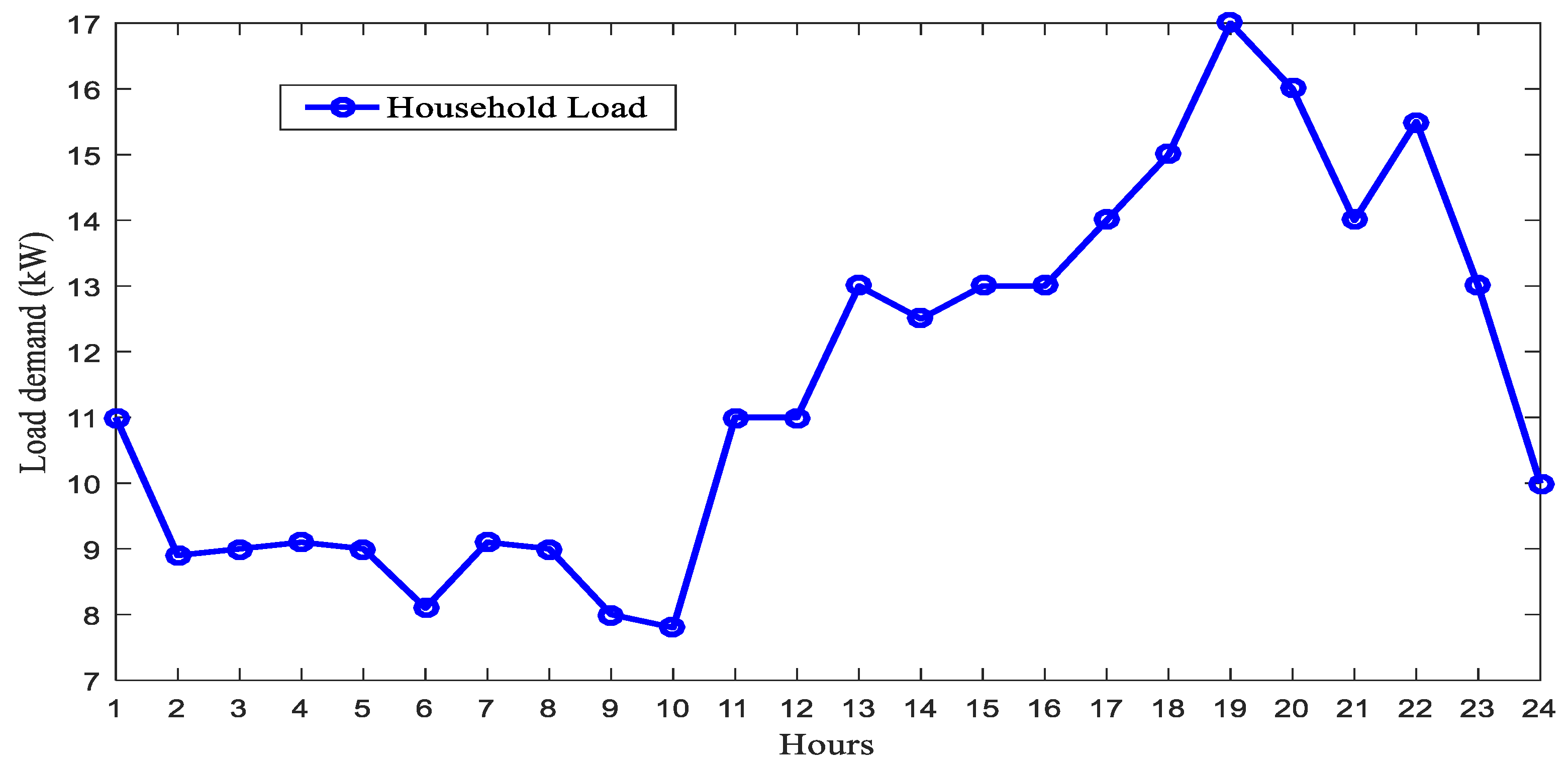


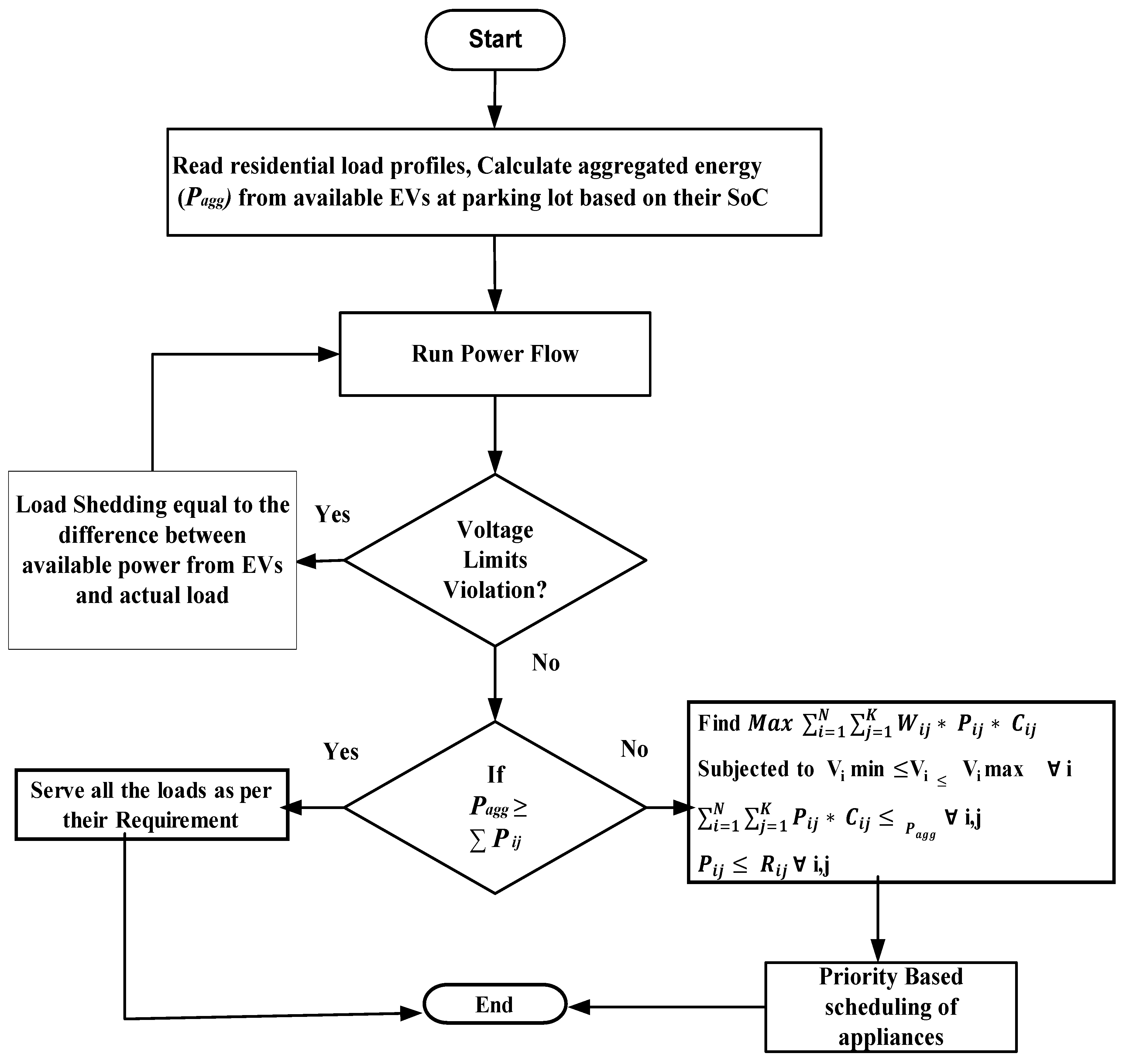
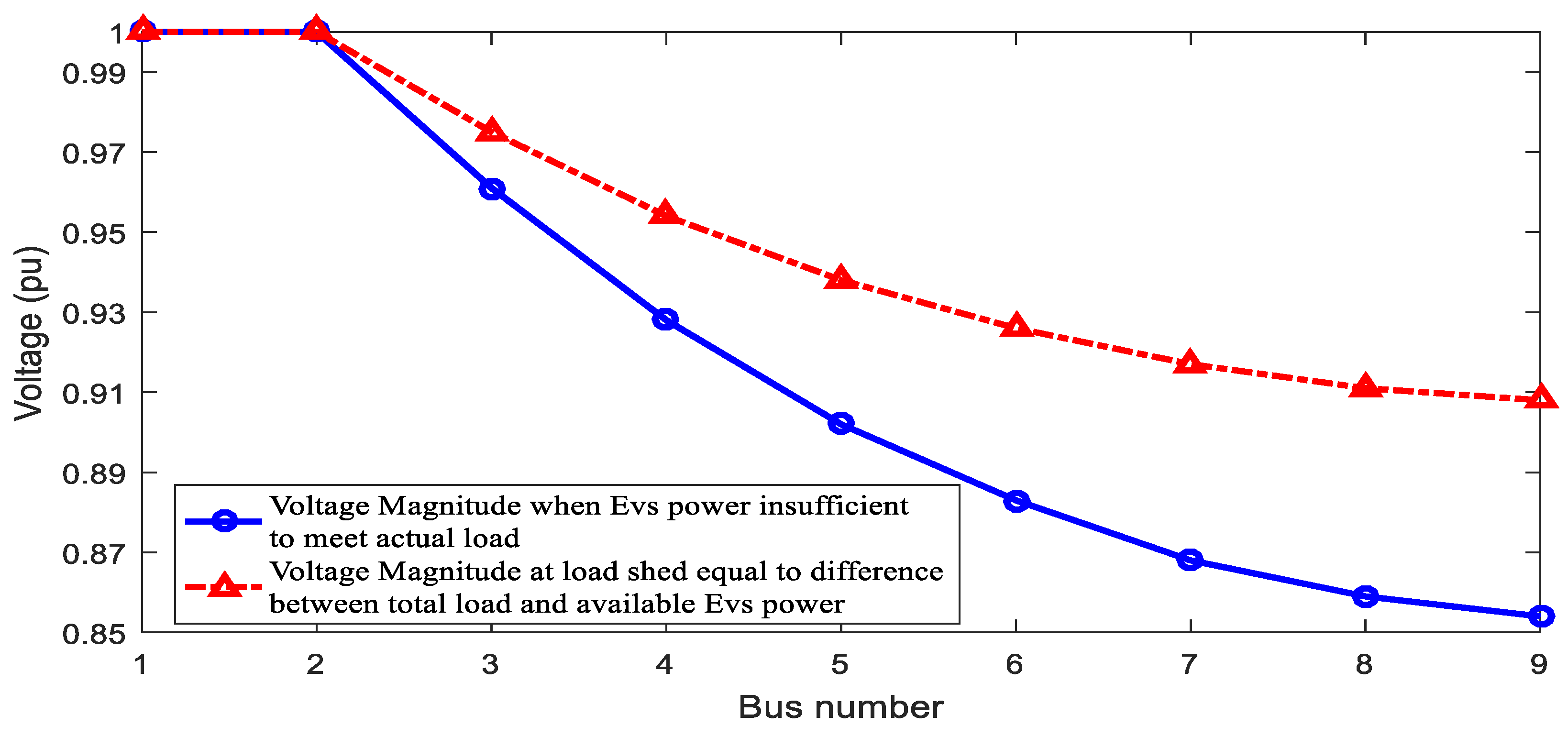
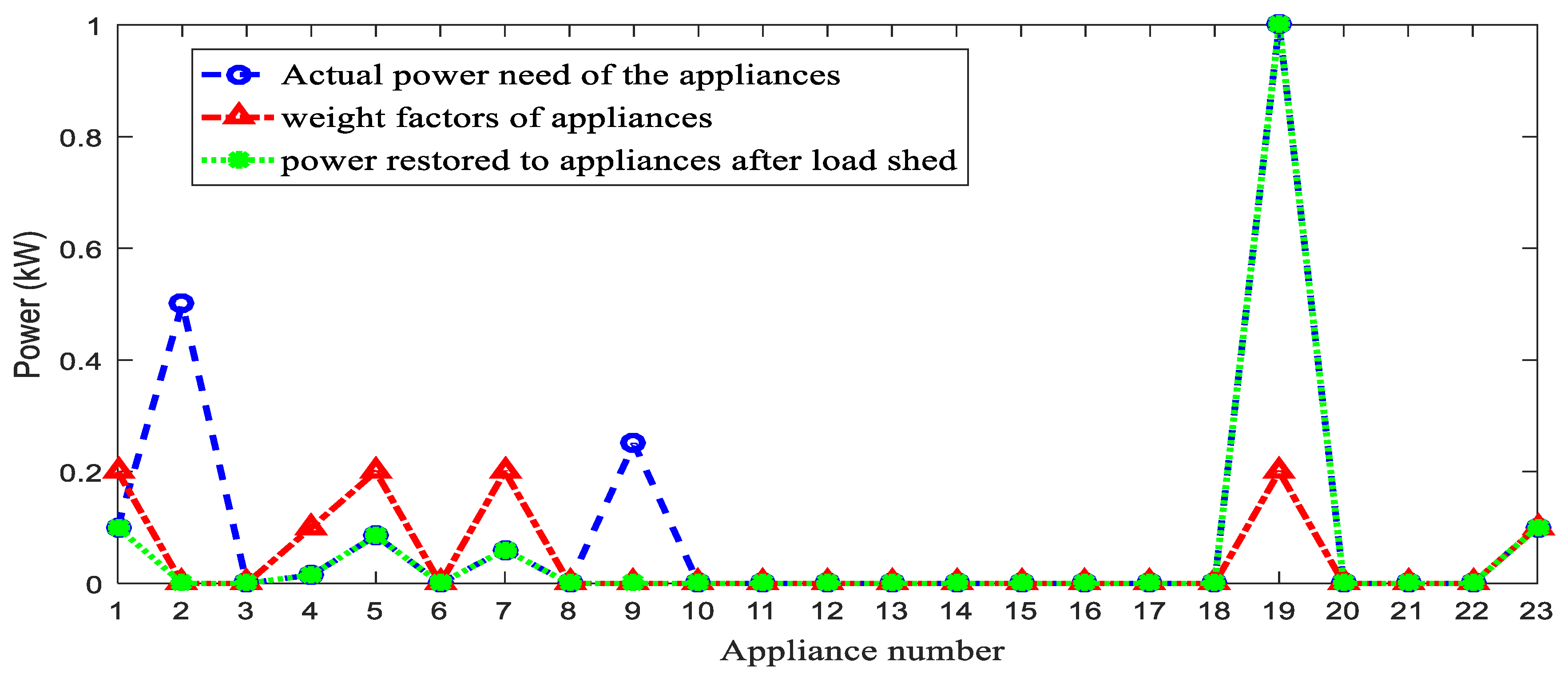
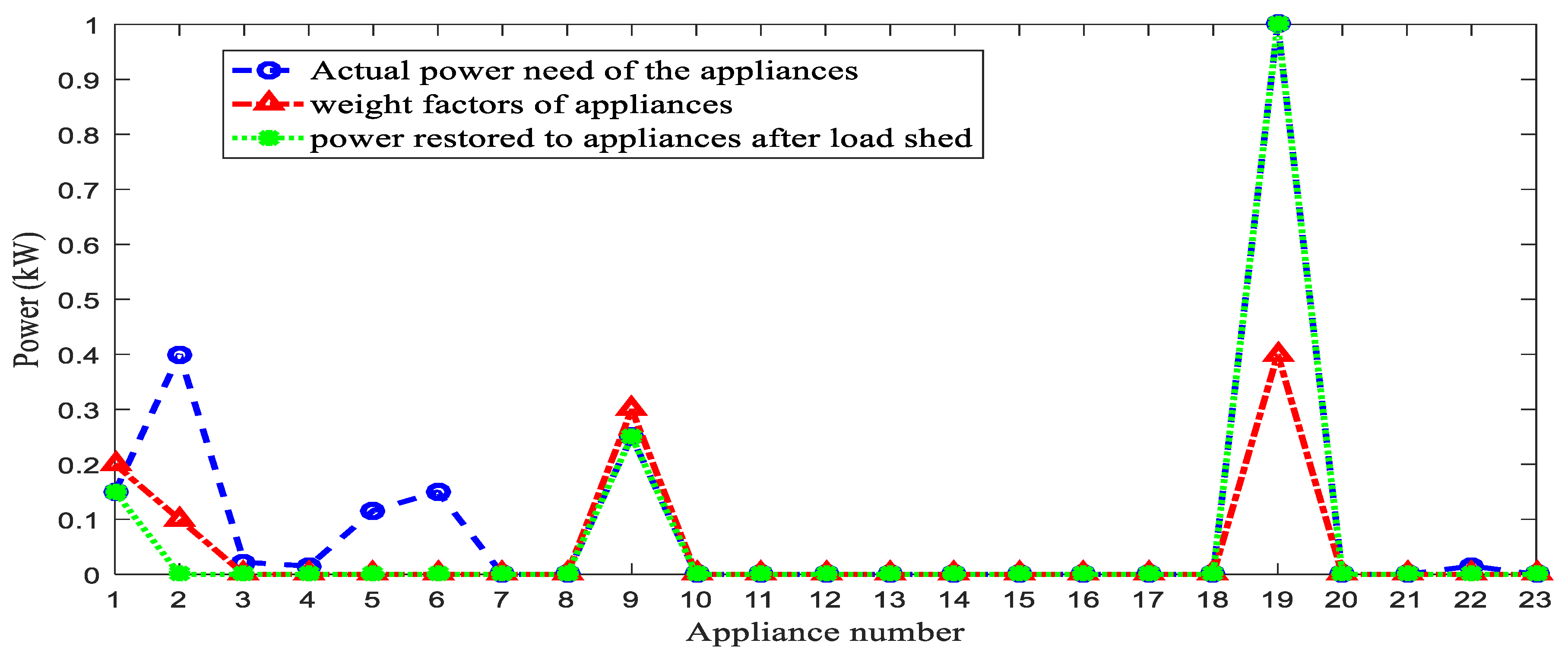
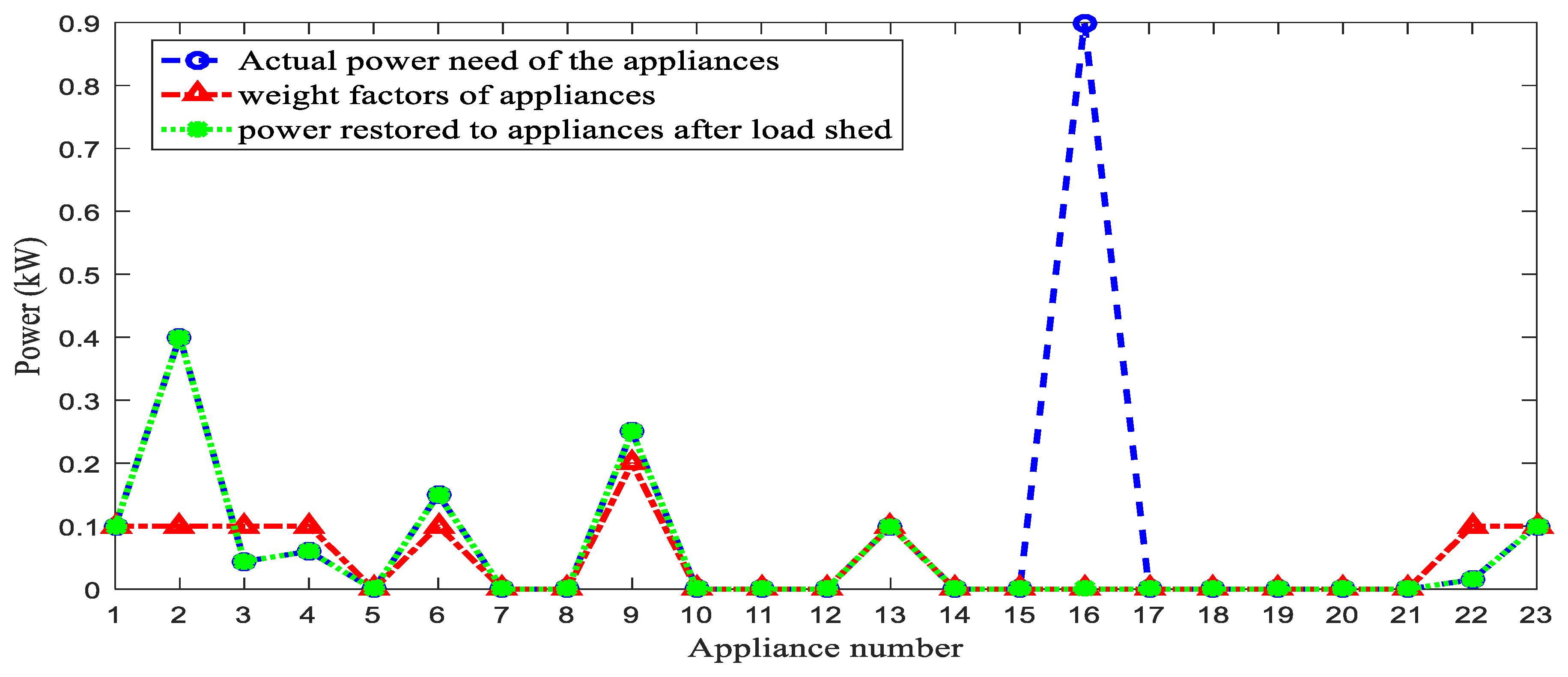
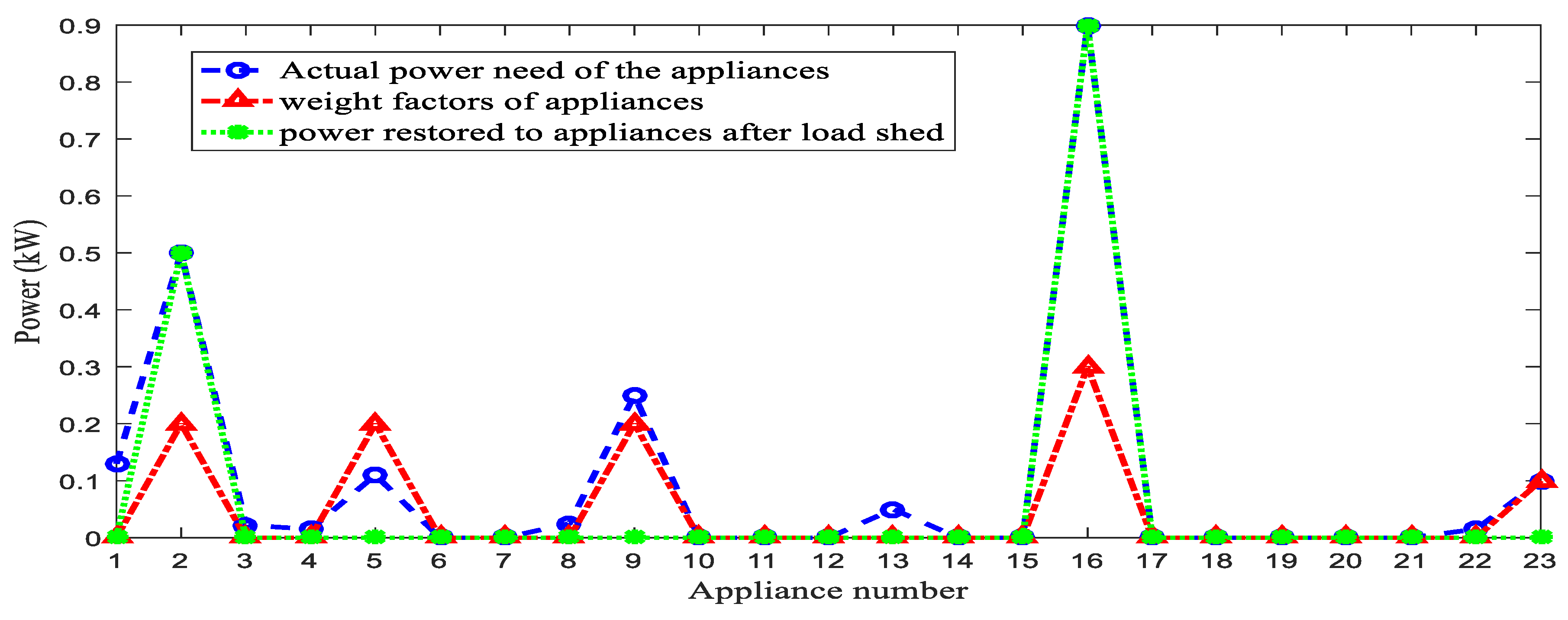

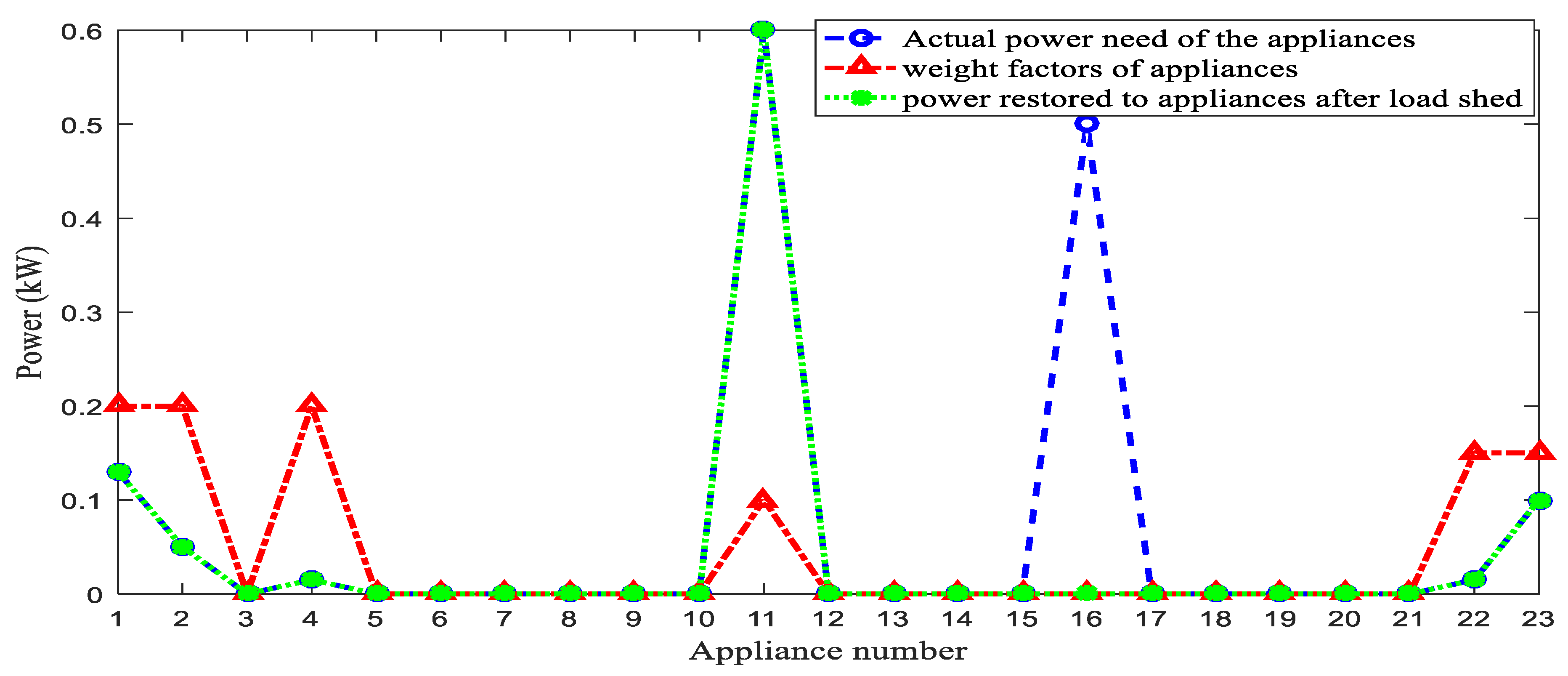
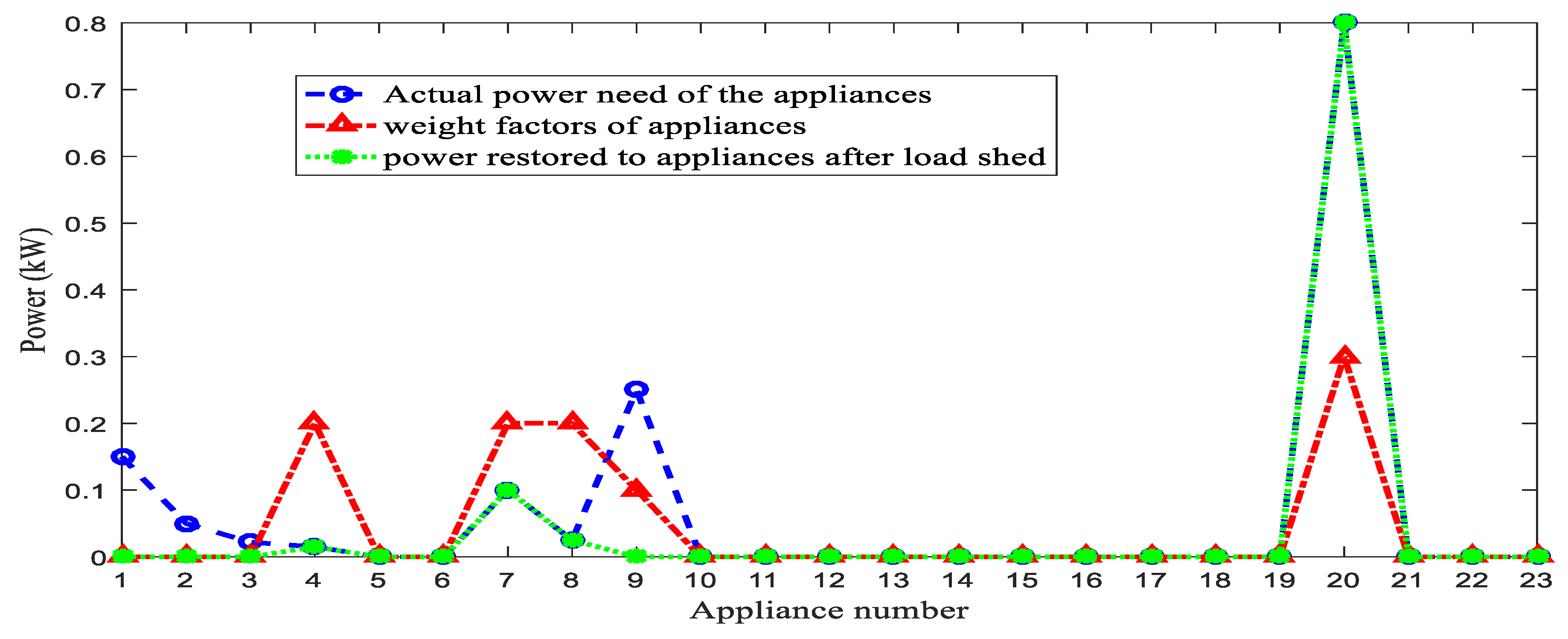
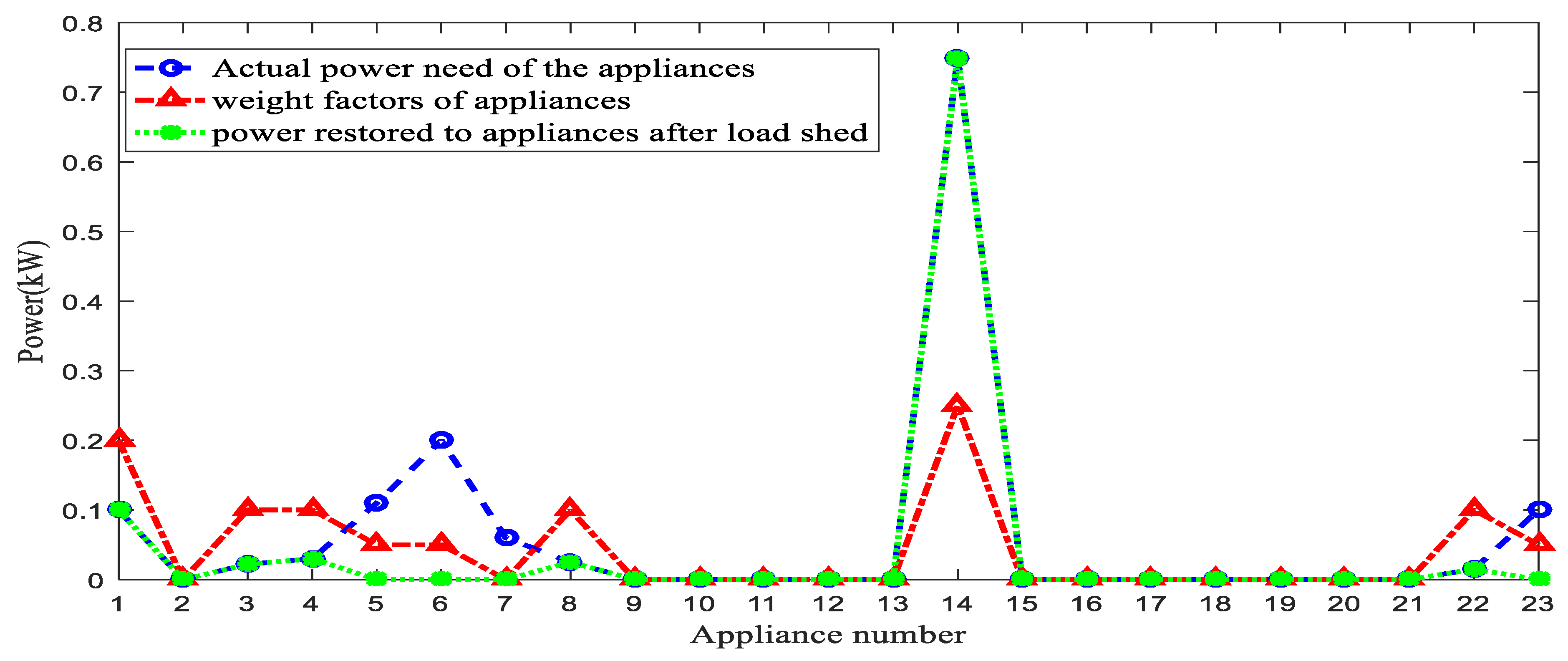
| Ref. No. | Problem | Solution Approach | Merits | Demerits |
|---|---|---|---|---|
| [3] | Distribution system restoration using PHEVs | Mixed-integer linear programming is implemented. 100-bus test system was considered. | Coordination between transmission and distribution restoration was obtained. | The availability of a large number of PHEVs and their participation were concerns. |
| [4] | Service restoration using DGs | The decentralized multi-agent system (MAS) framework and service restoration was formulated as the multi-objective optimization problem. | Addressed the uncertainty in load demand and renewable distributed generators (RDGs) for service restoration. | Powerful control architecture was required for communication between the agents of the MAS. |
| [6] | Co-optimized distribution system restoration | Co-optimized repair crew and mobile power sources. A mixed-integer linear programming method was proposed. | Methods to reduce the computational time, the repair tasks, and MPS connection pre-processing were proposed. | Needed good coordination at every stage of implementation and involved many data variables. |
| [10] | Smart service restoration with distributed generation | The Tabu search approach was proposed to solve constrained objective functions. | Sub-transmission and distribution systems were considered with all crucial objectives. | Many data variables were involved and needed more input data. |
| [11] | Service restoration in distribution systems using a hybrid multi-agent approach | Used DGs and EVs. Multi-objective, multi-constraint, combinatorial, nonlinear optimization problem. | The optimal positions of DGs and islanding ranges were determined. | Required a powerful control architecture of a hybrid MAS. Fewer switching operations are not taken care of. |
| [13] | Multi-level service restoration strategy of a distribution network | Utilized the microgrid (MG) and EVs. An optimal power flow (OPF) model was constructed to minimize the net loss after the service restoration. | A potential aspect of EVs and MGs was considered. | The availability of sufficient capacity from MGs and the number of EVs to participate readily were concerns. |
| [14] | Service restoration of an active distribution network using DGs | A multi-objective, multiple-constraint, complex optimization problem was proposed. | Prioritized loads were restored, improved the economic benefits of the grid, and reduced the loss of the network fault recovery. | The intermittent nature of renewable DGs may not provide support all the time. |
| S.No. | Appliances | Wattage(W) × Quantity | |||||||
|---|---|---|---|---|---|---|---|---|---|
| Residential User-1 | Residential User-2 | Residential User-3 | Residential User-4 | Residential User-5 | Residential User-6 | Residential User-7 | Residential User-8 | ||
| 1 | Refrigerator | 100 × 1 | 150 × 1 | 100 × 1 | 130 × 1 | 130 × 1 | 130 × 1 | 150 × 1 | 100 × 1 |
| 2 | freezer | 500 × 1 | 400 × 1 | 400 × 1 | 500 × 1 | 50 × 1 | 50 × 1 | 50 × 1 | 400 × 1 |
| 3 | Tube lights | None | 22 × 3 | 22 × 3 | 22 × 3 | 22 × 3 | 22 × 3 | 22 × 3 | 22 × 3 |
| 4 | Lamps | 15 × 4 | 15 × 3 | 15 × 3 | 15 × 3 | 15 × 3 | 15 × 3 | 15 × 3 | 15 × 3 |
| 5 | LED TV | 85 × 1 | 116 × 1 | 120 × 1 | 110 × 1 | 60 × 1 | 85 × 1 | 90 × 1 | 110 × 1 |
| 6 | Desktop | 150 × 1 | 150 × 1 | 150 × 1 | 150 × 1 | 200 × 1 | 150 × 1 | 150 × 1 | 200 × 1 |
| 7 | Laptop | 60 × 1 | 60 × 1 | 60 × 1 | - | 60 × 1 | 60 × 1 | 100 × 1 | 60 × 1 |
| 8 | Phones | 25 × 2 | 25 × 2 | 25 × 2 | 25 × 2 | 25 × 2 | 25 × 3 | 25 × 1 | 25 × 1 |
| 9 | Blender | 250 × 1 | 250 × 1 | 250 × 1 | 250 × 1 | 250 × 1 | 250 × 1 | 250 × 1 | - |
| 10 | Electric kettle | - | - | 1200 × 1 | 1200 × 1 | 1200 × 1 | 1200 × 1 | 1200 × 1 | 1200 × 1 |
| 11 | Microwave | 900 × 1 | 900 × 1 | 900 × 1 | 900 × 1 | 900 × 1 | 600 × 1 | 900 × 1 | 900 × 1 |
| 12 | Iron | 1000 × 1 | 1000 × 1 | 1000 × 1 | 1000 × 1 | 800 × 1 | 1000 × 1 | 1000 × 1 | 1000 × 1 |
| 13 | Security light | 25 × 6 | 25 × 6 | 25 × 6 | 25 × 6 | 25 × 6 | 25 × 6 | 25 × 6 | 25 × 6 |
| 14 | Waterpump | 750 × 1 | 750 × 1 | 750 × 1 | 750 × 1 | 750 × 1 | 750 × 1 | 750 × 1 | 750 × 1 |
| 15 | Waterheater | 1000 × 1 | 1000 × 1 | 1000 × 1 | 1000 × 1 | - | 1000 × 1 | 1000 × 1 | 1000 × 1 |
| 16 | Washing Machine | 900 × 1 | 900 × 1 | 900 × 1 | 900 × 1 | 900 × 1 | 500 × 1 | 900 × 1 | 900 × 1 |
| 17 | Dishwasher | 1200 × 1 | 1200 × 1 | 1200 × 1 | 1200 × 1 | 1200 × 1 | 1200 × 1 | 1200 × 1 | 1200 × 1 |
| 18 | Electricstove | 2000 × 1 | 2000 × 1 | 2000 × 1 | 2000 × 1 | 2000 × 1 | 2000 × 1 | 2000 × 1 | 2000 × 1 |
| 19 | ElectricpressureCooker | 1000 × 1 | 1000 × 1 | 1000 × 1 | 1000 × 1 | 1000 × 1 | 1000 × 1 | 1000 × 1 | 1000 × 1 |
| 20 | Coffee maker | 1400 × 1 | 1400 × 1 | 1400 × 1 | 1400 × 1 | 1400 × 1 | 1400 × 1 | 800 × 1 | 1400 × 1 |
| 21 | Air Conditioner | 1500 × 1 | 1500 × 1 | 1500 × 1 | 1500 × 1 | 1000 × 1 | 1000 × 1 | 1000 × 1 | 1000 × 1 |
| 22 | Internet Router | - | 15 × 1 | 15 × 1 | 15 × 1 | 15 × 1 | 15 × 1 | 15 × 1 | 15 × 1 |
| 23 | Waterpurifier | 100 × 1 | 100 × 1 | 100 × 1 | 100 × 1 | 100 × 1 | 100 × 1 | 100 × 1 | 100 × 1 |
| Sl.No. | Hour Number | Number of EVs Available | Available Power from EVs (kW) | Total Load (kW) | Status of Voltage Limits before Load Shedding |
|---|---|---|---|---|---|
| 1 | 1 | 2 | 7.49 | 10.33916 | Violated |
| 2 | 2 | 5 | 24.19 | 9.7942246 | Not violated |
| 3 | 3 | 5 | 18.62 | 9.2970252 | Not violated |
| 4 | 4 | 3 | 15.56 | 8.885042 | Not violated |
| 5 | 5 | 3 | 12.29 | 8.5883301 | Not violated |
| 6 | 6 | 3 | 15.74 | 8.4295185 | Not violated |
| 7 | 7 | 4 | 20.35 | 8.4238109 | Not violated |
| 8 | 8 | 5 | 22.85 | 8.5789847 | Not violated |
| 9 | 9 | 2 | 12.67 | 8.8953919 | Not violated |
| 10 | 10 | 2 | 11.33 | 9.3659586 | Not violated |
| 11 | 11 | 5 | 25.73 | 9.9761853 | Not violated |
| 12 | 12 | 3 | 11.72 | 10.704147 | Violated |
| 13 | 13 | 5 | 11.52 | 11.520491 | Violated |
| 14 | 14 | 2 | 10.18 | 12.388442 | Violated |
| 15 | 15 | 3 | 12.1 | 13.263797 | Violated |
| 16 | 16 | 4 | 9.41 | 14.094927 | Violated |
| 17 | 17 | 2 | 7.3 | 14.822779 | Violated |
| 18 | 18 | 5 | 11.52 | 15.380871 | Violated |
| 19 | 19 | 5 | 12.1 | 15.6953 | Violated |
| 20 | 20 | 2 | 8.07 | 15.684732 | Violated |
| 21 | 21 | 2 | 10.95 | 15.260411 | Violated |
| 22 | 22 | 4 | 12.1 | 14.326153 | Violated |
| 23 | 23 | 5 | 11.52 | 12.778351 | Violated |
| 24 | 24 | 3 | 10.75 | 10.505969 | Violated |
| Number of residential users interrupted | 8 |
| Duration of the power outage | 1 h |
| Power needed in kW | 14.09 |
| Total residential appliances to run | 69 |
|
Number of residential users
interrupted | 0 |
| Duration of the power outage | 1 h |
| Power restored from EVs in kW | 9.116 |
| Total residential appliances served | 39 |
Publisher’s Note: MDPI stays neutral with regard to jurisdictional claims in published maps and institutional affiliations. |
© 2022 by the authors. Licensee MDPI, Basel, Switzerland. This article is an open access article distributed under the terms and conditions of the Creative Commons Attribution (CC BY) license (https://creativecommons.org/licenses/by/4.0/).
Share and Cite
Ganapaneni, S.; Pinni, S.V.; Reddy, C.R.; Aymen, F.; Alqarni, M.; Alamri, B.; Kraiem, H. Distribution System Service Restoration Using Electric Vehicles. Energies 2022, 15, 3264. https://doi.org/10.3390/en15093264
Ganapaneni S, Pinni SV, Reddy CR, Aymen F, Alqarni M, Alamri B, Kraiem H. Distribution System Service Restoration Using Electric Vehicles. Energies. 2022; 15(9):3264. https://doi.org/10.3390/en15093264
Chicago/Turabian StyleGanapaneni, Swapna, Srinivasa Varma Pinni, Ch. Rami Reddy, Flah Aymen, Mohammed Alqarni, Basem Alamri, and Habib Kraiem. 2022. "Distribution System Service Restoration Using Electric Vehicles" Energies 15, no. 9: 3264. https://doi.org/10.3390/en15093264
APA StyleGanapaneni, S., Pinni, S. V., Reddy, C. R., Aymen, F., Alqarni, M., Alamri, B., & Kraiem, H. (2022). Distribution System Service Restoration Using Electric Vehicles. Energies, 15(9), 3264. https://doi.org/10.3390/en15093264








